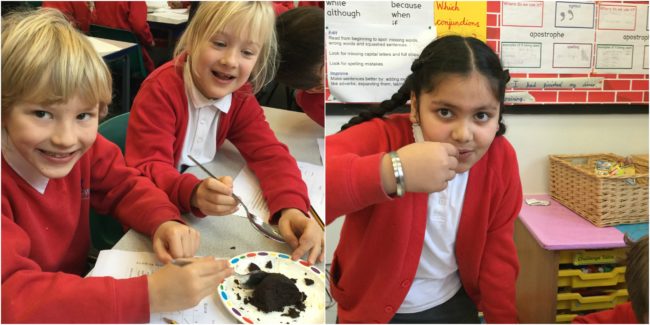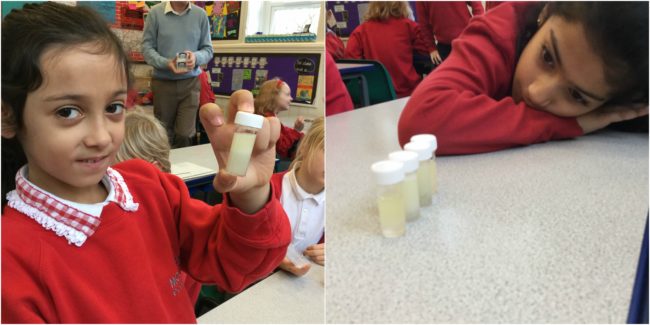Forces – levers and pulleys
This week, we started our new mini-topic: Forces. We’re focusing on levers and pulleys.
To begin with, we used some paper and a toy car to figure out what we we already know about forces. Help at home by asking your child what forces act on a toy car or a falling piece of paper.
After that, we investigated levers and pulleys. Levers and pulleys are essentially a mechanism to exert a larger amount of force with less effort. To demonstrate this we did a little experiment:

That’s right. Despite weighing less than half what I do, Noah was able to lift me up. Ask your child how this works?
We also thought about more common examples of levers and pulleys – ones we might use in everyday life like scissors (ask your child about how were going to remember the silent ‘c’ in the word scissors) and lifts.
Tomorrow, we’ll begin working on a little project, in which we’ll apply our knowledge of forces, levers and pulleys: (attempting) making a rube goldberg machine.
Homework review
Thanks to those parents who joined us for our weekly homework review. As I expected, there were a number of brilliant homeworks, celebrating the great learning we did throughout STEM week.
Here are a few of our favourites.
Great job, Year 6!
Sports stars
As part of our involvement with the Leeds North East School Sport Partnership and Active Schools, we have recently entered two sporting competitions. A huge well done to all children who took part. For a few, this was their first opportunity to represent our school.
Leeds North East Primary Schools Sportshall Athletics
Fifteen pupils from Year 4, 5 and 6, took part in this action-packed competition, at Allerton Grange, comprising of many field and track events. It’s always a well-contested event and the children competed well against other local schools.
- ‘I enjoyed everything I did. Our team was very positive.’
- ‘It was a great experience that wasn’t too competitive. I loved it!’
- ‘I enjoyed the competition because there were lots of events to choose and do.’
Thank you to Mrs Bald and Mrs Russell for taking the children to this event.
Leeds North East Primary Schools Cross Country Festival
Eighteen pupils participated in the Leeds North East Primary Schools Cross Country Festival at Cardinal Heenan. There were over 650 young people taking part in the races and over 100 pupils in each race.
A particular well done to Grace and Megan who came 7th and 10th in their Year 5 girls race. Also, children commented on the resilience of Ripley who took a fall in the mud but got himself up and then continued to overtake many other runners!
- ”I thought it was good because it was different and my mum used to do cross country too.’
- ‘It was really good because even if you don’t like running too much, like me, you still had a fun time.’
As always, we thank staff and parents who helped with these events.
School Saving Club paying in session

Our next paying in date for School Saving Club account holders is Thursday 08 December 3.15-3.45pm. If you can’t make this date, the next one will be on Thursday 02 February at 3.15-3.45pm.
Children must be accompanied to the sessions.
Alternatively, you can bring money to the office in a sealed envelope marked School Saving Club for the attention of Miss Hale.
School Saving Club accounts can still be opened. Please ask at the office for an application form.
Children who are in currently in Year 3 will have their account credited by Leeds City Council with £10 once opened.
Physical activity – the facts
In August 2016, the Government released its Childhood Obesity Strategy. This document outlines actions which will address the rising rates of childhood obesity.
Yorkshire Sport Foundation have produced the following poster with statistics and key information from the strategy.

We continue to monitor and improve our physical activity provision (see our current PE Provision Plan (pe-and-sport-premium-2016-2017) and our previous PE Provision Plan (pe-and-sport-premium-2015-2016).
Phonics mornings
Thank you for attending our Maths Mornings last week.
We hope you enjoyed them and found them useful.
Don’t forget this week’s Phonics Mornings.
Packed lunches
Struggling for ideas for a healthy packed lunch?
Change4life have some great tips and easy to prepare ideas based on the Eatwell Guide.

Also make reference to our Packed Lunch Guidance.
Food Science
Lucy from Marks and Spencer’s came in and taught us about the science that goes into their famous melt-in-the-middle puddings. We learnt about emulsifiers and the role these play in the pudding. I think our favourite part was the taste test. What a great job that would be!


STEM Project
The following pictures sum up our project. After finding out how elastic band cars work, we designed and planned our own. The children had to make decisions about the size of the wheels, type of elastic band and the style of the frame. Each group planned something different which was good to see!
We began making the frame and then added the mounts for the axles. When we tested out the axles, we discovered a problem – can your child tell you what it was? So we found some different axles to use and carefully measured, marked and sawed these. After some gluing of the wheels, the cars were ready for their power source – the elastic band. Can your child explain to you how the elastic band makes the car work?
We were so excited to test the cars! Unfortunately, they didn’t work as well as we had hoped. There were many things wrong including wheel-spinning, glue stopping the wheels from spinning, axles which were too short, wheels falling off…
However, Year 3 were resilient and resourceful and managed to fix all these problems themselves and improved the performance of the car! I was so proud of how well they worked together to solve these problems.
When they were finally ready, we had a competition and the winning team’s car went over one and a half metres!
Well done, Year 3!










